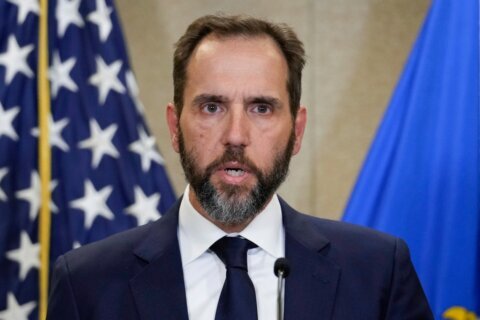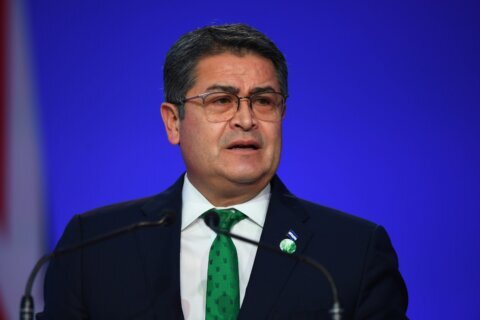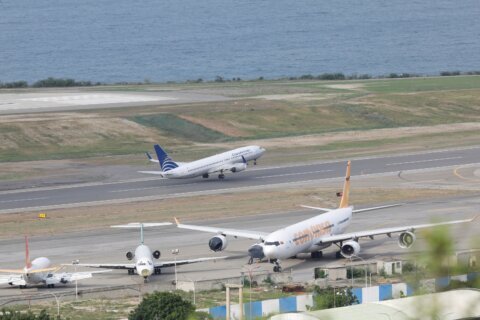JOHN SEEWER
Associated Press
TOLEDO, Ohio (AP) — Toxins possibly from algae on Lake Erie fouled the water supply of the state’s fourth-largest city Saturday, forcing officials to issue warnings not to drink the water and the governor to declare a state of emergency as worried residents descended on stores, quickly clearing shelves of bottled water.
“It looked like Black Friday,” said Aundrea Simmons, who stood in a line of about 50 people at a pharmacy before buying four cases of water. “I have children and elderly parents. They take their medication with water.”
The city advised about 400,000 residents in Toledo, most of its suburbs and a few areas in southeastern Michigan not to brush their teeth with or boil the water because that would only increase the toxin’s concentration. The mayor also warned that children should not shower or bathe in the water and that it shouldn’t be given to pets.
Toledo issued the warning just after midnight after tests at one treatment plant showed two sample readings for microsystin above the standard for consumption.
Gov. John Kasich said it was too early to say how long the advisory will last or what caused toxins to spike suddenly in the drinking water. Officials were waiting on test results on water samples.
“We don’t really want to speculate on this,” he told The Associated Press. “When it comes to this water, we’ve got be very careful.”
Toledo Mayor D. Michael Collins said it would probably be Sunday morning before all the results are in and officials could consider after that whether to lift the advisory.
The governor and his staff said state agencies were working to bring water and other supplies to areas around Toledo while also assisting hospitals and other affected businesses.
“What’s more important than water? Water’s about life,” Kasich said. “We know it’s difficult. We know it’s frustrating.”
Algae blooms during the summer have become more frequent and troublesome around the western end of Lake Erie, the shallowest of the five Great Lakes.
The algae growth is fed by phosphorus mainly from farm fertilizer runoff and sewage treatment plants, leaving behind toxins that have contributed to oxygen-deprived dead zones where fish can’t survive. The toxins can kill animals and sicken humans.
Scientists had predicted a significant bloom of the blue-green algae this year, but they didn’t expect it to peak until early September.
Kasich’s emergency order issued Saturday allowed the state to begin bringing water into the Toledo area. Large containers were being filled with water at a prison near Columbus and trucked about 130 miles north to Toledo, said Joe Andrews, a spokesman for the Ohio Department of Public Safety.
The state also asked major grocery chains to divert as much water as they can to northwest Ohio, Andrews said.
As truckloads of water came in from across the state, Toledo leaders set up distribution centers at schools around the city, limiting families to one case of bottled water. Some stores were receiving new shipments of water and putting limits on how much people can buy. The Red Cross was helping distribute water to homebound residents.
“We’re going to be prepared to make sure people are not without water,” the mayor said.
He pleaded with residents not to panic. There were no reports of people becoming sick from drinking the water, Collins said.
Samples of water were flown to the federal and state Environmental Protection Agency offices in Cincinnati and Columbus and a university in Michigan for additional testing, officials said.
State EPA Director Craig Butler said that the first tests indicating trouble with the water came Friday night and that additional testing confirmed the elevated readings. He said the water coming from the lake into Toledo’s water plant had relatively low toxicity levels this summer until this sudden spike that sent residents scrambling for clean water.
Police officers were called to stores early Saturday morning as people lined up to buy bottled water, bags of ice and flavored water.
“People were hoarding it. It’s ridiculous,” said Monica Morales, who bought several cases of bottled water before the store sold out of water a half-hour after opening.
Stores in cities up to 50 miles away were reporting shortages of bottled water. Some neighboring communities that aren’t connected to Toledo’s water system were offering their water to people who brought their own bottles and containers.
Operators of water plants all along Lake Erie, which supplies drinking water for 11 million people, have been concerned over the last few years about toxins fouling their supplies.
Almost a year ago, one township just east of Toledo told its 2,000 residents not to drink or use the water coming from their taps. That was believed to be the first time a city has banned residents from using the water because of toxins from algae in the lake.
Most water treatment plants along the western Lake Erie shoreline treat their water to combat the algae. Toledo spent about $4 million last year on chemicals to treat its water and combat the toxins.
Copyright 2014 The Associated Press. All rights reserved. This material may not be published, broadcast, rewritten or redistributed.







